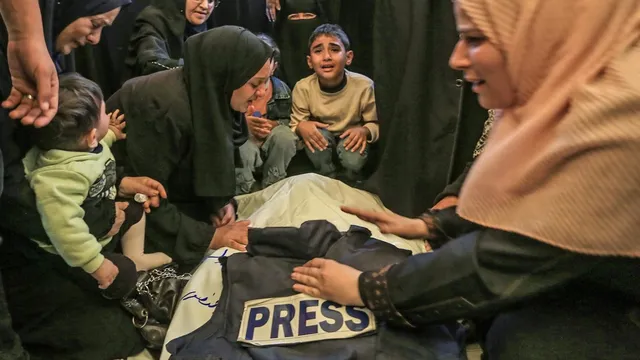
Israeli airstrike kills journalists amid ongoing conflict in Gaza
2025-04-08 23:13- Several journalists were killed in an Israeli airstrike in Gaza, including Ahmed Mansour and Hilmi Al-Faqawi.
- The airstrike targeted a tent where media personnel were present, aggravating concerns over the safety of journalists in conflict areas.
- This incident brings attention to the alarming number of journalist fatalities during the ongoing conflict, prompting calls for international action.
Express your sentiment!
Insights
In Gaza, an Israeli airstrike during the evening of a Sunday recently resulted in the tragic deaths of several journalists, including Ahmed Mansour and his colleague Hilmi Al-Faqawi. Additionally, Yousef Al-Khozindar, who worked with NBC News to provide essential support, was killed in the attack. This airstrike highlights the dangers faced by media workers in conflict zones and has raised concerns about the targeting of journalists in recent hostilities. Following the attack, the Israeli military claimed the airstrike was aimed at Hassan Aslih, described as a 'terrorist' linked to Hamas, asserting that he was using his role as a journalist as a cover. This has sparked significant international outrage, particularly from organizations advocating for press freedom. The Committee to Protect Journalists reported that 2024 has seen the highest number of journalist fatalities globally, with Israel accounting for a considerable portion of those deaths, presenting alarming statistics that paint a dire picture for the press in conflict areas. With over 175 journalists killed in Gaza since the start of hostilities, this attack emphasizes a disturbing trend of violence against media personnel, drawing condemnation from the international community, urging for accountability and protective measures under international humanitarian law.
Contexts
Media workers in conflict zones often find themselves in perilous situations, facing unique challenges that can jeopardize their safety and their ability to perform their jobs effectively. As these professionals endeavor to report on the realities of war, political upheaval, and human rights violations, they confront threats ranging from physical violence to censorship. Journalists, photographers, and other media personnel must navigate a landscape that is often hostile, lacking in basic protections, and rife with the potential for dangerous encounters with armed groups, government forces, or even hostile civilians. This context highlights the urgent need for adequate training, protective measures, and support systems tailored to the conditions faced in these environments. Many media organizations have recognized the risks associated with conflict reporting and have implemented training programs aimed at equipping journalists with critical survival skills. Such training includes understanding escape routes, first-aid techniques, and methods for identifying and mitigating hazards in the field. However, despite these efforts, the challenges persist as not all media workers have equal access to such resources. Freelance journalists, in particular, often operate under precarious conditions, lacking the backing of a larger organization that can provide them with necessary training and support, making them particularly vulnerable in conflict situations. As the landscape of media consumption evolves, the role of media workers in conflict zones becomes increasingly important yet fraught with risks. Social media and the internet have transformed how news is disseminated, allowing real-time updates from the frontlines. However, these platforms also expose journalists to new vulnerabilities, such as online harassment, doxxing, and increased surveillance by conflicting parties. Furthermore, the proliferation of misinformation can endanger the credibility of legitimate reports, putting media professionals at further risk, as various groups may seek to delegitimize credible reporting. International awareness and advocacy for the rights and protection of media workers in conflict zones remain critical. Organizations such as the Committee to Protect Journalists and Reporters Without Borders play a vital role in highlighting abuses and advocating for policies that safeguard journalists. Continued engagement by governments, civil society, and media organizations is essential to create a safer environment for media workers. Initiatives fostering collaboration between local journalists and international bodies can contribute significantly to improving conditions, ensuring that the voices of those affected by conflict are heard and reported accurately, despite the inherent dangers they face.